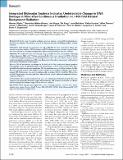| dc.contributor.author | Olipitz, Werner | |
| dc.contributor.author | Shuga, Joe | |
| dc.contributor.author | Pang, Bo | |
| dc.contributor.author | McFaline, Jose Luis | |
| dc.contributor.author | Lonkar, Pallavi | |
| dc.contributor.author | Thomas, Aline | |
| dc.contributor.author | Mutamba, James Tendai | |
| dc.contributor.author | Greenberger, Joel S. | |
| dc.contributor.author | Samson, Leona D. | |
| dc.contributor.author | Dedon, Peter C. | |
| dc.contributor.author | Yanch, Jacquelyn C. | |
| dc.contributor.author | Engelward, Bevin P. | |
| dc.contributor.author | Wiktor-Brown, Dominika | |
| dc.date.accessioned | 2012-11-16T20:45:25Z | |
| dc.date.available | 2012-11-16T20:45:25Z | |
| dc.date.issued | 2012-04 | |
| dc.identifier.issn | 0091-6765 | |
| dc.identifier.issn | 1552-9924 | |
| dc.identifier.uri | http://hdl.handle.net/1721.1/74671 | |
| dc.description.abstract | Background: In the event of a nuclear accident, people are exposed to elevated levels of continuous low dose-rate radiation. Nevertheless, most of the literature describes the biological effects of acute radiation.
Objectives: DNA damage and mutations are well established for their carcinogenic effects. We assessed several key markers of DNA damage and DNA damage responses in mice exposed to low dose-rate radiation to reveal potential genotoxic effects associated with low dose-rate radiation.
Methods: We studied low dose-rate radiation using a variable low dose-rate irradiator consisting of flood phantoms filled with 125Iodine-containing buffer. Mice were exposed to 0.0002 cGy/min (~ 400-fold background radiation) continuously over 5 weeks. We assessed base lesions, micronuclei, homologous recombination (HR; using fluorescent yellow direct repeat mice), and transcript levels for several radiation-sensitive genes.
Results: We did not observe any changes in the levels of the DNA nucleobase damage products hypoxanthine, 8-oxo-7,8-dihydroguanine, 1,N6-ethenoadenine, or 3,N4-ethenocytosine above background levels under low dose-rate conditions. The micronucleus assay revealed no evidence that low dose-rate radiation induced DNA fragmentation, and there was no evidence of double strand break–induced HR. Furthermore, low dose-rate radiation did not induce Cdkn1a, Gadd45a, Mdm2, Atm, or Dbd2. Importantly, the same total dose, when delivered acutely, induced micronuclei and transcriptional responses.
Conclusions: These results demonstrate in an in vivo animal model that lowering the dose-rate suppresses the potentially deleterious impact of radiation and calls attention to the need for a deeper understanding of the biological impact of low dose-rate radiation. | en_US |
| dc.description.sponsorship | United States. Dept. of Energy (DE-FG02-05ER64053) | en_US |
| dc.description.sponsorship | United States. Dept. of Energy (R33-CA112151) | en_US |
| dc.description.sponsorship | United States. Dept. of Energy (1U19AI68021-06) | en_US |
| dc.description.sponsorship | National Institutes of Health (U.S.) (NIH ES02109) | en_US |
| dc.description.sponsorship | National Institutes of Health (U.S.) (grant P01-CA026731) | en_US |
| dc.description.sponsorship | Austrian Academy of Sciences | en_US |
| dc.description.sponsorship | National Institute of General Medical Sciences (U.S.) (Interdepartmental Biotechnology Training Program (GM008334)) | en_US |
| dc.language.iso | en_US | |
| dc.publisher | National Center for Biotechnology Information | en_US |
| dc.relation.isversionof | http://dx.doi.org/10.1289/ehp.1104294 | en_US |
| dc.rights | Article is made available in accordance with the publisher's policy and may be subject to US copyright law. Please refer to the publisher's site for terms of use. | en_US |
| dc.source | PMC | en_US |
| dc.title | Integrated Molecular Analysis Indicates Undetectable Change in DNA Damage in Mice after Continuous Irradiation at ~ 400-fold Natural Background Radiation | en_US |
| dc.type | Article | en_US |
| dc.identifier.citation | Olipitz, Werner et al. “Integrated Molecular Analysis Indicates Undetectable Change in DNA Damage in Mice After Continuous Irradiation at ~ 400-fold Natural Background Radiation.” Environmental Health Perspectives 120.8 (2012): 1130–1136. Web. | en_US |
| dc.contributor.department | Massachusetts Institute of Technology. Center for Environmental Health Sciences | en_US |
| dc.contributor.department | Massachusetts Institute of Technology. Department of Biological Engineering | en_US |
| dc.contributor.department | Massachusetts Institute of Technology. Department of Biology | en_US |
| dc.contributor.department | Massachusetts Institute of Technology. Department of Nuclear Science and Engineering | en_US |
| dc.contributor.mitauthor | Olipitz, Werner | |
| dc.contributor.mitauthor | Wiktor-Brown, Dominika | |
| dc.contributor.mitauthor | Shuga, Joe | |
| dc.contributor.mitauthor | Pang, Bo | |
| dc.contributor.mitauthor | McFaline, Jose Luis | |
| dc.contributor.mitauthor | Lonkar, Pallavi | |
| dc.contributor.mitauthor | Thomas, Aline | |
| dc.contributor.mitauthor | Mutamba, James Tendai | |
| dc.contributor.mitauthor | Samson, Leona D. | |
| dc.contributor.mitauthor | Dedon, Peter C. | |
| dc.contributor.mitauthor | Yanch, Jacquelyn C. | |
| dc.contributor.mitauthor | Engelward, Bevin P. | |
| dc.relation.journal | Environmental Health Perspectives | en_US |
| dc.eprint.version | Final published version | en_US |
| dc.type.uri | http://purl.org/eprint/type/JournalArticle | en_US |
| eprint.status | http://purl.org/eprint/status/PeerReviewed | en_US |
| dspace.orderedauthors | Olipitz, Werner; Wiktor-Brown, Dominika; Shuga, Joe; Pang, Bo; Mcfaline, Jose L.; Lonkar, Pallavi; Thomas, Aline; Mutamba, James T.; Greenberger, Joel S.; Samson, Leona D.; Dedon, Peter C.; Yanch, Jacquelyn C.; Engelward, Bevin P. | en_US |
| dc.identifier.orcid | https://orcid.org/0000-0003-0011-3067 | |
| dc.identifier.orcid | https://orcid.org/0000-0002-7112-1454 | |
| dspace.mitauthor.error | true | |
| mit.license | PUBLISHER_POLICY | en_US |
| mit.metadata.status | Complete | |
